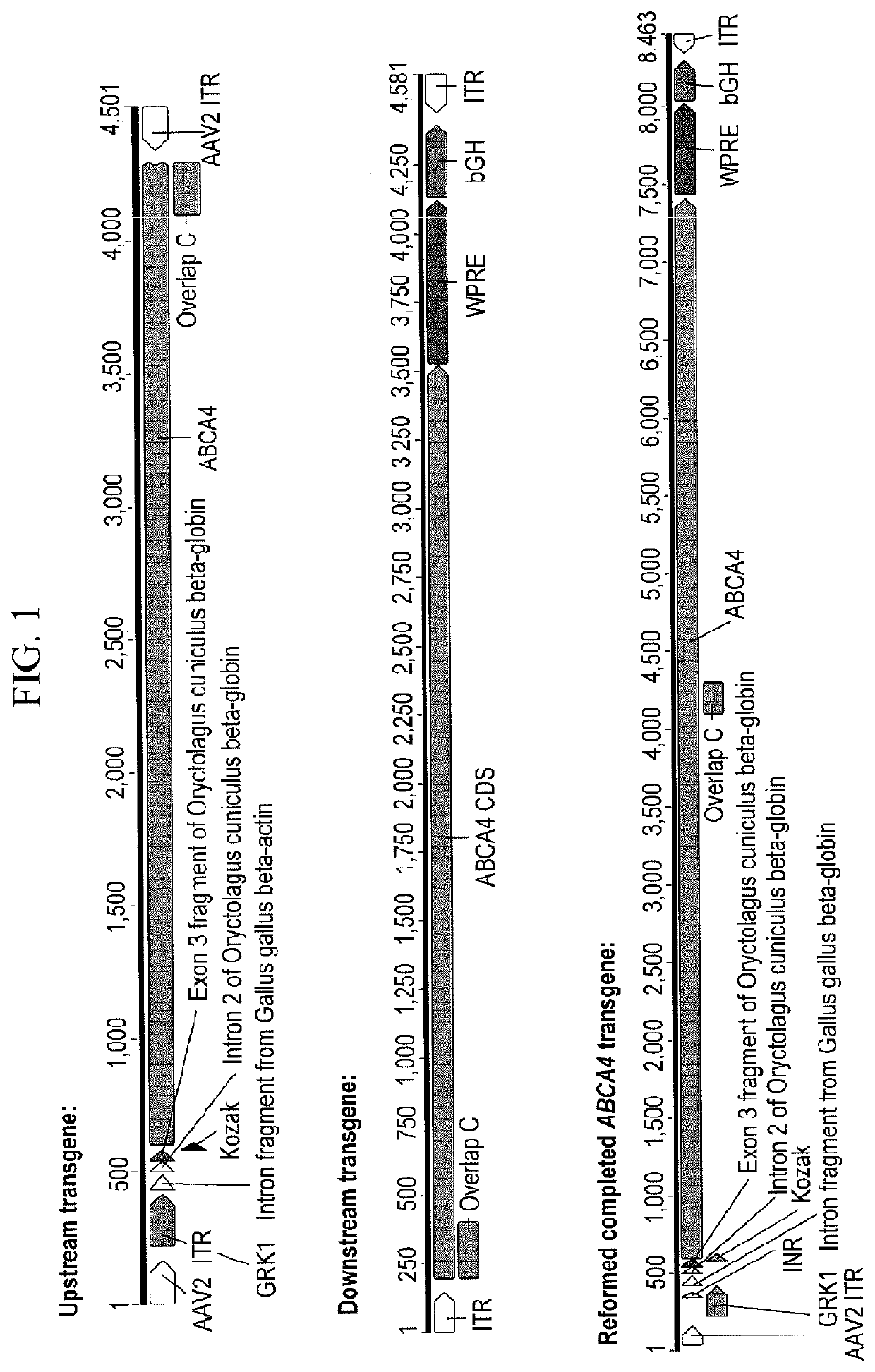Compositions and methods for the treatment of stargardt disease
a technology of stargardt disease and compositions, applied in the field of compositions and methods for the treatment of stargardt disease, can solve the problems of lipofuscin toxic granules, formation and accumulation of bisretinoid, and lack of functional abca4 protein in retinal cells
- Summary
- Abstract
- Description
- Claims
- Application Information
AI Technical Summary
Benefits of technology
Problems solved by technology
Method used
Image
Examples
example 1
on of Upstream and Downstream AAV Vectors
[0423]The generation of a given AAV vector comprised three plasmids: pTransgene, pRepCap and pHelper. pTransgene contains either the upstream or downstream ABCA4 transgene as detailed below (ITR integrity confirmed). pRepCap contains the rep and cap genes of the AAV genome. The rep genes are from the AAV2 genome whereas the cap genes varies depending on serotype requirement. pHelper contains the required adenoviral genes necessary for successful AAV generation. The plasmids are complexed with polyethylenimine (PEI) for a triple transfection mix that is applied to HEK293T cells, and HEK293T cells were transfected using a typical PEI protocol to deliver the required plasmids: pRepCap, pHelper (pDeltaAdF6) and pTransgene. HEK293T cells were grown in HYPERFlasks (SLS, UK) and transfected using a typical PEI protocol to deliver a total of 500 pg of the required plasmids: pRepCap, pHelper (pDeltaAdF6) and pTransgene. Cells were harvested three days...
example 2
and Cloning of Exemplary AAV Vectors
[0424]Adeno-associated virus (AAV) is the current vector of choice for retinal gene therapy due to its ability to diffuse through the various cell layers within the retinal structure, low immunogenicity, excellent tropism for photoreceptor cells and extensive proof of concept in a variety of pre-clinical models. Human clinical trials have shown safety and efficacy with AAV vectors in the retina and gene therapy trials for multiple conditions have been reported in the past decade with more currently ongoing. For some disorders such as Stargardt disease, the therapeutic genes are too large to fit within a transgene that can be packaged into a single AAV capsid. Gene therapy replacement for these disorders is therefore an intriguing challenge. Given the restricted packaging capacity of AAV, its potential to treat “large gene” diseases initially seemed limited, yet more recent studies have indicated that AAV gene therapy delivery of genes over 3.5 kb ...
example 3
t of Overlap Zones
[0443]Having identified an optimal vector and ABCA4 sequence to use for recombination, the effects of varying the overlap length of base pairing between plus and minus strands were assessed.
TABLE 2Transgene Information (nucleotide numbering in Table 2 is relative to ABCA4 CDS, SEQ ID NO: 11).UpstreamShortTransgeneABCA4DownstreamShortTransgeneABCA4OverlapGC contentDual vector / transgenenamelengthCDStransgenenamelengthCDSlengthof overlapoverlap nameGRK1.coABCCOu4.9 kb1-4,326coCA4.WPRE.pACOd4.9 kb3,154-6,8221.1kb55%coAGRK1.ABCAaUp14.9 kb1-4,326aCA4.WPRE.pADoA4.9 kb3,154-6,8221.1kb55%AGRK1.ABCbUp24.3 kb1-3,701bCA4.WPRE.pADoB4.8 kb3,196-6,8220.5kb54%BGRK1.ABCbUp24.3 kb1-3,701cCA4.WPRE.pADoC4.6 kb3,494-6,8220.2kb52%CGRK1.ABCbUp24.3 kb1-3,701dCA4.WPRE.pADoD4.5 kb3,603-6,8220.1kb48%DGRK1.ABCbUp24.3 kb1-3,701eCA4.WPRE.pADoE4.4 kb3,653-6,8220.05kb47%EGRK1.ABCbUp24.3 kb1-3,701fCA4.WPRE.pADoF4.4 kb3,678-6,8220.02kb38%FGRK1.ABCbUp24.3 kb1-3,701xCA4.WPRE.pADoX4.3 kb3,702-6,8220kb...
PUM
| Property | Measurement | Unit |
|---|---|---|
| length | aaaaa | aaaaa |
| nucleic acid sequence | aaaaa | aaaaa |
| nucleic acid | aaaaa | aaaaa |
Abstract
Description
Claims
Application Information
 Login to View More
Login to View More - R&D
- Intellectual Property
- Life Sciences
- Materials
- Tech Scout
- Unparalleled Data Quality
- Higher Quality Content
- 60% Fewer Hallucinations
Browse by: Latest US Patents, China's latest patents, Technical Efficacy Thesaurus, Application Domain, Technology Topic, Popular Technical Reports.
© 2025 PatSnap. All rights reserved.Legal|Privacy policy|Modern Slavery Act Transparency Statement|Sitemap|About US| Contact US: help@patsnap.com



